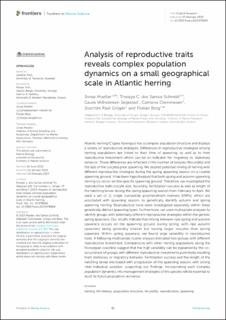| dc.contributor.author | Müller, Jonas | |
| dc.contributor.author | dos Santos Schmidt, Thassya Christina | |
| dc.contributor.author | Seljestad, Gaute Wilhelmsen | |
| dc.contributor.author | Clemmensen, Catriona | |
| dc.contributor.author | Gröger, Joachim | |
| dc.contributor.author | Berg, Florian | |
| dc.date.accessioned | 2023-07-03T12:32:19Z | |
| dc.date.available | 2023-07-03T12:32:19Z | |
| dc.date.created | 2023-02-19T16:34:02Z | |
| dc.date.issued | 2023 | |
| dc.identifier.issn | 2296-7745 | |
| dc.identifier.uri | https://hdl.handle.net/11250/3075379 | |
| dc.description.abstract | Atlantic herring (Clupea harengus) has a complex population structure and displays a variety of reproductive strategies. Differences in reproductive strategies among herring populations are linked to their time of spawning, as well as to their reproductive investment which can be an indicator for migratory vs. stationary behavior. These differences are reflected in the number of oocytes (fecundity) and the size of the oocytes prior spawning. We studied potential mixing of herring with different reproductive strategies during the spring spawning season on a coastal spawning ground. It has been hypothesized that both spring and autumn spawning herring co-occur on this specific spawning ground. Therefore, we investigated the reproductive traits oocyte size, fecundity, fertilization success as well as length of the hatching larvae during the spring spawning season from February to April. We used a set of 11 single nucleotide polymorphism markers (SNPs), which are associated with spawning season, to genetically identify autumn and spring spawning herring. Reproductive traits were investigated separately within these genetically distinct spawning types. Furthermore, we used multivariate analyses to identify groups with potentially different reproductive strategies within the genetic spring spawners. Our results indicate that mixing between ripe spring and autumn spawners occurs on the spawning ground during spring, with ripe autumn spawners being generally smaller but having larger oocytes than spring spawners. Within spring spawners, we found large variability in reproductive traits. A following multivariate cluster analysis indicated two groups with different reproductive investment. Comparisons with other herring populations along the Norwegian coastline suggest that the high variability can be explained by the co-occurrence of groups with different reproductive investments potentially resulting from stationary or migratory behavior. Fertilization success and the length of the hatching larvae decreased with progression of the spawning season, with strong inter-individual variation, supporting our findings. Incorporating such complex population dynamics into management strategies of this species will be essential to build its future population resilience. | |
| dc.description.abstract | Analysis of reproductive traits reveals complex population dynamics on a small geographical scale in Atlantic herring | |
| dc.language.iso | eng | |
| dc.title | Analysis of reproductive traits reveals complex population dynamics on a small geographical scale in Atlantic herring | |
| dc.title.alternative | Analysis of reproductive traits reveals complex population dynamics on a small geographical scale in Atlantic herring | |
| dc.type | Peer reviewed | |
| dc.type | Journal article | |
| dc.description.version | publishedVersion | |
| dc.source.volume | 10 | |
| dc.source.journal | Frontiers in Marine Science | |
| dc.identifier.doi | 10.3389/fmars.2023.978694 | |
| dc.identifier.cristin | 2127314 | |
| cristin.ispublished | true | |
| cristin.fulltext | original | |
| cristin.qualitycode | 1 | |
